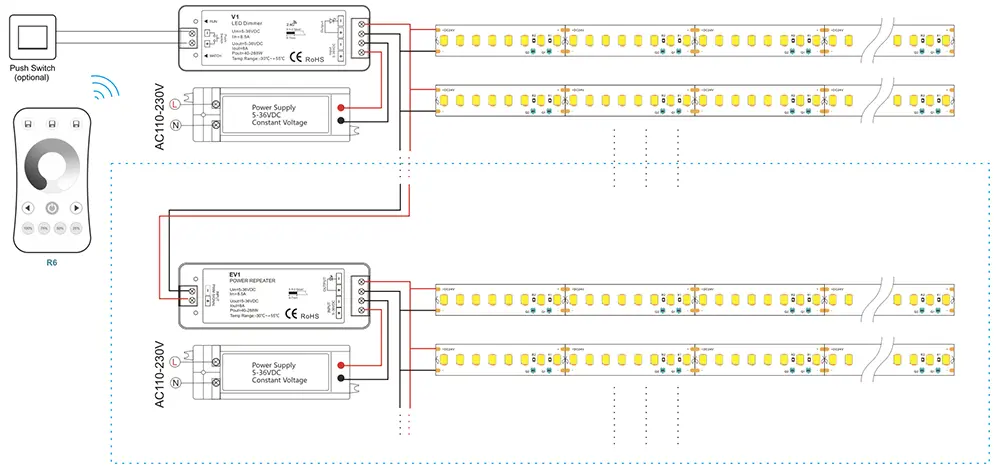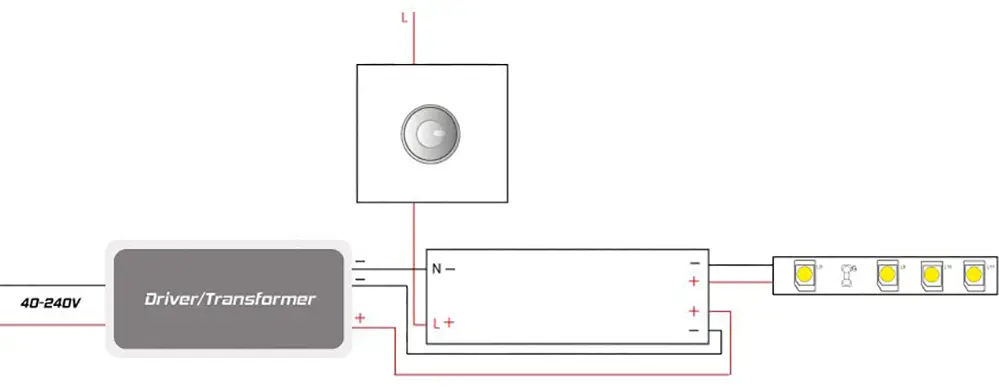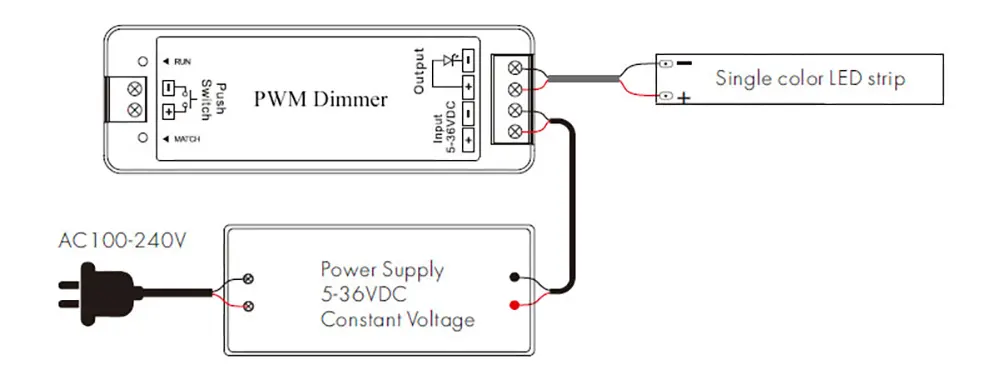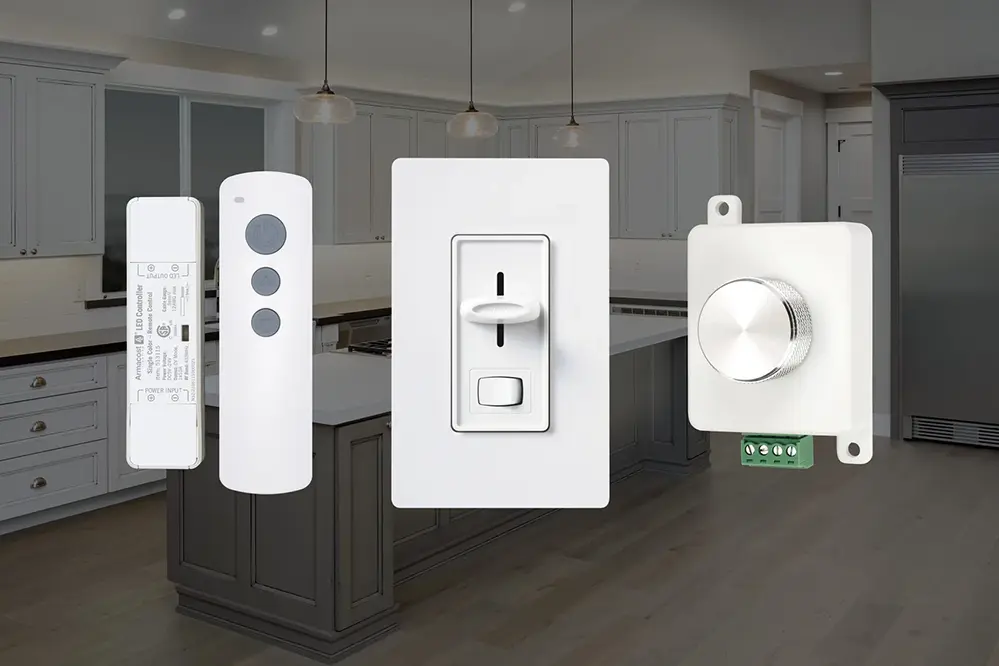LED strip lights are a versatile and popular lighting solution for both professionals and enthusiasts alike. But what if you want to take your lighting game to the next level and have more control over the brightness of your LED strips? Look no further! In this ultimate guide, we will show you exactly how to dim LED strip lights like a pro. Whether you’re a DIY enthusiast or a seasoned professional, this comprehensive guide will equip you with the knowledge and techniques to achieve the perfect lighting ambiance for any occasion.
Now, you might be wondering, who is behind this expert guide? Allow me to introduce myself – I’m Tom, an industry veteran with over 15 years of experience in the LED lighting industry. Throughout my career, I’ve witnessed the evolution of LED technology and have become a go-to resource for all things LED strip lights. Drawing from my extensive knowledge and expertise, I’ve meticulously crafted this blog post to provide you with the most accurate and up-to-date information on how to dim LED strip lights effectively.
So, let’s dive right in! Whether you’re looking to create a cozy atmosphere for a movie night or enhance your workspace with adjustable lighting, this guide will walk you through the various dimming methods and help you choose the right approach for your specific needs. From traditional TRIAC wall dimmers to low-voltage DC PWM dimmers, we’ll explore the pros and cons of each method, ensuring you have all the information you need to make an informed decision. Get ready to unlock the full potential of your LED strip lights and transform any space into a personalized oasis of light.
Understanding LED Strip Dimmability

The innate dimmability of LED strip lights emanates from their low-voltage DC power requirements, setting them apart from their AC-powered counterparts. This distinction, pivotal in practice, facilitates a reduction of luminary intensity without the complexities often encountered with AC dimming. To achieve nuanced control over the LED strip’s brightness, one must employ proper dimming apparatus calibrated for the task, ensuring seamless integration of the dimmer within the circuitry of the light system.
Conversely, it’s imperative to acknowledge that not all dimming solutions are created equal; they differ in the nuances of their operation and installation. Ensuring your dimming strategy aligns with the specifications of your LED strip light system is critical for achieving optimal functionality and avoiding the pitfalls of incompatible configurations.
Importance of Compatible Power Supplies
Precision in lighting demands the right power supply—critical for achieving the full dimming potential of LED strip lights.
Power supply quality is pivotal to dimmability; it shapes the light experience, ensuring seamless integration and robust performance.
Using a mismatched power supply risks compromising dimming capabilities, leading to suboptimal performance, inferior light quality, and potential flickering.
To avoid these issues, choosing a compatible power supply ensures a flawlessly dimmable LED strip, embodying both function and subtlety in lighting design.
Role of Dimming Signals and PWM
Dimming signals are crucial for adjusting the LED strip illumination, varying from full brightness to a softer glow. These electrical impulses dictate the luminosity, allowing tailored lighting experiences suitable for various settings.
Pulse Width Modulation (PWM) is the primary technology behind this control. It modulates the power supplied to the LEDs by adjusting the pulse’s width—hence the name—enabling precise brightness regulation without altering the light color.
Working in concert, dimming signals control the PWM’s on-off cycle frequency, essentially turning the LEDs on and off at rapid intervals. This cycle modulates brightness while maintaining light quality, creating a seamless and flicker-free dimming effect.
With PWM, the human eye perceives a continuous light output rather than individual pulses due to the high speed of these cycles. The effective dimming range and light stability critically depend on the PWM frequency and the system’s ability to process dimming signals without distortion.
Traditional TRIAC Dimming Solution

When integrating LED strip lights into a space with existing AC-based dimming infrastructure, one may opt for the Traditional TRIAC Dimming Solution. This method entails the use of a TRIAC dimmable power supply designed to function in conjunction with a conventional TRIAC wall dimmer. The key lies in the power supply’s ability to convert and lower the high-voltage AC current to a suitable low-voltage DC output while concurrently interpreting the TRIAC dimmer’s phase-cut signals. The resultant DC output modulates the LED strip’s brightness in harmony with the wall dimmer’s positional adjustments. This solution is particularly attractive in settings where the lighting system requires seamless integration with pre-existing architectural dimming controls.
Selecting a TRIAC Dimmable Power Supply
Identifying a compatible TRIAC dimmable power supply is crucial for integrating LED strip lights with existing wall dimmers.
- Assess Voltage Compatibility: Ensure the power supply matches the voltage requirement of your LED strip, typically 12V or 24V.
- Verify Load Capacity: Check that the power supply can handle the total wattage of your LED strips.
- Understand Dimming Range: Choose a supply that provides a suitable dimming range for your application.
- Prioritize Compatibility: Confirm that the power supply is designed to work with the specific TRIAC dimmer in use.
- Check for Certifications: Look for safety and performance certifications such as UL or ETL.
- Consider Form Factor: Select a power supply with a physical size appropriate for your installation space.
Proper electrical specifications are vital to ensure both performance and safety.
With the right power supply, your LED strip system will dim smoothly and reliably, providing the desired ambiance.
Integrating with Wall Dimmers
Establishing an effective link between LED strips and wall dimmers necessitates meticulous planning and appropriate electrical infrastructure. The initial step involves selecting a compatible TRIAC dimmable power supply that precisely matches the voltage and current specifications of the LED strip.
Subsequent to the power supply choice, the wall dimmer’s compatibility must be confirmed to avoid performance inconsistencies. Compatibility between the dimmer and the power supply ensures that the dimming signal is accurately interpreted and translated into the desired lighting level.
Furthermore, consider the wall dimmer’s electrical rating to guarantee it aligns with the electrical load of the LED strips. Doing so assures that the dimmer can efficiently and safely modulate the intensity of the LED illumination without risk of overload or failure.
Account for the necessity of a stable installation environment to accommodate the TRIAC dimmable power supply. Adequate physical space ensures accessibility for maintenance while also contributing to the overall safety and durability of the lighting system.
The integration of wall dimmers requires an understanding of both AC and DC electrical systems. An adept integration ensures seamless operability and eliminates the risk of electrical hazards or malfunctions.
Finally, ensure the power supply is certified and listed for use with the intended dimmer model. Compliance with prevailing safety standards is imperative to safeguard both functionality and user security.
Simplified Dimming with DC PWM

For those seeking an uncomplicated and effective means to adjust their LED strip lighting, DC PWM dimming presents a highly practical solution. This approach sidesteps the intricacies of AC dimming methods while still delivering precise control over brightness levels, streamlining the dimming process significantly.
The beauty of a DC PWM dimmer lies in its simplicity—a modest rotary potentiometer typically serves as the central control element, visually unobtrusive and furnishing immediate response to user adjustments. Such ease of use aligns perfectly with applications where flexibility and straightforward operation are paramount, without the need for complex wiring or specialized power supplies.
Choosing a Standard Power Supply
Selecting the right power supply is crucial for LED strip longevity and performance. It must match the voltage and capacity needs of your LEDs to prevent malfunction.
Consider the total wattage of your LED strip when choosing a power supply. A power supply with insufficient wattage can lead to underperformance or even damage to the LED strip.
In addition to wattage, factor in the power supply’s efficiency. High-efficiency units waste less electricity as heat, which could otherwise impact the ambient temperature and potentially affect the LED strip longevity.
Also, assess the power supply’s design for your installation space. Compact and well-ventilated designs are preferable, especially in confined areas where heat dissipation can be a challenge.
Lastly, verification of the power supply’s compatibility with dimming controllers is requisite. It ensures seamless dimming without flicker or erratic behavior, securing your lighting project’s success.
Connecting a DC PWM Dimmer
Incorporating a DC PWM dimmer into your LED strip setup offers precise control over brightness levels without complex wiring.
- Identify the power supply and ensure it is not TRIAC dimmable, but standard DC compatible.
- Connect the power supply’s output wires to the input terminals of the PWM dimmer.
- Attach the LED strip’s input wires to the output terminals of the dimmer.
- Adjust the dial on the PWM dimmer to test and set the desired brightness level.
The connection process typically does not require specialized tools, contributing to a straightforward installation.
Ensure the dimmer is positioned close to the LED strip to prevent voltage drop, which can affect overall illumination quality.
Troubleshooting Common Dimming Issues
When encountering flickering or unresponsive dimming with your LED strip lights, it’s imperative to pinpoint whether the problem arises from the power supply, the dimmer unit, or the LED strip itself. Careful scrutiny of each component’s connections and ensuring proper compatibility can mitigate such issues and restore desired functionality.
At times, non-linear dimming presents as an uneven adjustment of brightness levels. This can usually be rectified by recalibrating the dimmer or replacing incompatible components, thus achieving a smooth transition across the dimming spectrum.
Managing Non-Linear Dimming
Non-linear dimming occurs when the light output does not proportionally correspond to the dimmer setting. To troubleshoot this, one might start by recalibrating the dimmer control.
In some cases, a simple recalibration may not suffice. It may be necessary to replace the dimmer unit.
A meticulous examination of the power supply specifications against the dimmer’s requirements can illuminate the root of non-linear dimming problems. Inconsistencies here often manifest as abrupt changes in brightness levels, rather than the smooth transition desired.
Addressing non-linear dimming can involve more than basic adjustments; trial and error with different dimmer models or power supplies may be required. The ultimate goal is to achieve a seamless correlation between the dimmer’s position and the LED strip’s luminance, ensuring a predictable and consistent dimming experience without the annoyance of flicker or erratic changes.
Preventing Voltage Drop and Flickering
Voltage drop and flickering can mar an otherwise well-designed LED strip installation. Proper planning and application are key to mitigating these issues.
- Use appropriate gauge wires for your installation to ensure adequate current flow and minimal voltage drop.
- Select a power supply with a higher output voltage at the onset to counter potential voltage drop along the strip’s length.
- Keep the length of your LED strips within the manufacturer’s recommended maximum to prevent voltage drop across the strip.
- Employ voltage repeaters or amplifiers when running long lengths of LED strip to maintain consistent voltage and brightness.
- Opt for regulated power supplies that can adjust the voltage and current to the load dynamically, reducing flickering.
- Test all components together before final installation to catch any potential issues of compatibility or performance.
Voltages that are consistent and regulated ensure an even distribution of power, minimizing instances of flicker.
A disciplined approach to matching power supply capacity, wire gauge, and LED strip length will greatly reduce voltage inconsistencies and flickering effects.
FAQs
Can I dim my LED strip without a specialized dimmer?
No, utilizing either a TRIAC dimmer with a compatible power supply or a PWM dimmer is necessary for proper dimming.
Are all LED strip lights dimmable?
Yes, virtually all LED strip lights are dimmable. Unlike common household LED bulbs that may be labeled as “not dimmable,” LED strips are designed to be dimmable with the appropriate DC electrical signal. LED strips require a power supply to convert higher voltage AC into a lower 12V or 24V DC voltage. If a wall dimmer is involved, it must communicate with the power supply to enable dimming. Therefore, the dimmable or not dimmable question depends on the power supply’s ability to interpret the dimming signal produced by the wall dimmer. However, the LED strip itself can be freely adjusted in brightness with the correct DC electrical signal, typically PWM. So, when it comes to LED strip lights, you have the flexibility to create the perfect lighting ambiance for any occasion.
Do I always need a TRIAC dimmable power supply?
Not always; it depends on your dimming method preference and setup.
Is there a risk of flickering when dimming?
Yes, especially if the dimmer and power supply are not well-matched.
What is the maximum distance for a PWM dimmer to LED strip?
Place the PWM dimmer close to the LED strip to avoid voltage drop, which can cause brightness inconsistencies.
Can I connect the dimmer to any power supply?
Only with low-voltage DC PWM dimmers; TRIAC dimming requires a compatible power supply.
How to dim LED lights without a dimmer?
Dimming LED lights without a dimmer may seem challenging, but there are alternative methods available. One approach is to use pulse-width modulation (PWM) to adjust the brightness. PWM is a technique that rapidly switches the LED on and off at varying intervals, creating the illusion of dimming. This can be achieved by using a microcontroller or a specialized LED driver with built-in PWM functionality.
Another option is to use a resistor to reduce the current flowing through the LED. By adding a resistor in series with the LED, the overall voltage drop decreases, resulting in reduced brightness. However, it is important to calculate the appropriate resistor value based on the LED’s forward voltage and desired current to avoid damaging the LED or causing it to malfunction.
Additionally, some LED lights come with built-in dimming options. These lights have a built-in control mechanism that allows you to adjust the brightness without the need for an external dimmer. This can be done through a dedicated remote control, a smartphone app, or even through voice commands if the lights are compatible with smart home systems.
It’s worth noting that while these methods can effectively dim LED lights without a dimmer, they may not offer the same level of control and smoothness as a dedicated dimming system. Therefore, if precise dimming control is essential, investing in a dimmer switch or compatible dimmable LED bulbs would be the ideal solution.
How to dim LED strip lights using remote?
To dim LED strip lights using a remote, it is important to follow a few steps. First, make sure you have a remote control that is compatible with your LED strip lights. Check the specifications or user manual for your LED strip lights to determine the type of remote control required.
Next, locate the receiver for the LED strip lights. This is usually a small box that connects to the power supply and the strip lights. It will have a receiver antenna that needs to be properly positioned to receive signals from the remote control.
Once you have the remote control and receiver ready, ensure that the LED strip lights are connected to a power source. Turn on the power and test the LED lights to make sure they are working properly.
To dim the LED strip lights, use the remote control and find the dimming function. This is often labeled as “brightness” or a light bulb icon with a +/- symbol. Press the “+” button to increase the brightness or the “-” button to decrease it. Some remotes may also have dedicated dimming buttons.
Adjust the brightness level by pressing the respective buttons until you achieve the desired lighting level. Experiment with different brightness levels to find the right ambiance for your space.
Remember to keep the remote control and receiver within the recommended range for proper signal transmission. If you encounter any issues, consult the user manual or contact the manufacturer for further troubleshooting steps. Enjoy the flexibility and convenience of dimming your LED strip lights with a remote control.
Can I dim LED strip lights without remote?
Yes, you can dim LED strip lights without a remote control. There are several ways to achieve this.
Firstly, some LED strip lights come with a built-in dimming feature. These lights have a control unit that allows you to adjust the brightness using a switch or a dial. Simply turn the switch or dial to your desired brightness level, and the LED strip lights will dim accordingly.
Alternatively, you can use a compatible external dimmer switch or dimming module. This device will connect to your LED strip lights and provide the dimming functionality. You can control the brightness using the switch or knob on the dimmer.
Another option is to use a smart lighting system or a home automation system. These systems typically have an app or a control panel that allows you to adjust the brightness of your LED strip lights. You can dim them remotely using your smartphone, tablet, or computer.
It’s important to note that not all LED strip lights are compatible with dimming. Before attempting to dim your LED strip lights, make sure to check the product specifications or consult the manufacturer to ensure that they are dimmable.
In conclusion, dimming LED strip lights without a remote control is possible by using built-in dimming controls, external dimmer switches or modules, or by integrating them into a smart lighting or home automation system.
What tools do I need to dim LED strips?
When it comes to dimming LED strips, there are a few tools that you will need to have on hand. Firstly, you will need a compatible LED dimmer switch. This switch will allow you to control the brightness of the LED strips. Make sure to choose a dimmer switch that is specifically designed for LED lighting, as other types of dimmers may not be compatible.
Additionally, you will need a power supply or driver for the LED strips. This is what supplies the necessary voltage and current to the LED strips. The power supply should be selected based on the power requirements of the LED strips and should be able to handle the total wattage of all the LED strips you plan to dim.
In some cases, you may also need connectors and wiring to connect the LED strips to the dimmer switch and power supply. These connectors and wiring should be chosen based on the specific requirements of your LED strips and the dimmer switch.
Overall, the key tools you will need to dim LED strips are a compatible LED dimmer switch, a power supply or driver, and potentially connectors and wiring. It’s important to ensure that all the components you choose are compatible with each other and capable of meeting the power and voltage requirements of your LED strips.
Conclusion
Dimming LED strip lights requires careful consideration of the components used. For permanent installations, a TRIAC dimmable power supply with a compatible wall dimmer is an elegant solution. Alternatively, low-voltage DC PWM dimmers offer simplicity and portability for temporary setups. Regardless of the method chosen, proper configuration and testing are crucial to avoid issues like flickering. Achieving seamless dimming enhances the functionality and ambiance of LED strip lighting.
If you’re in search of high-quality LED strip lights and LED neon strips, look no further than Unitop, a professional Chinese manufacturer. With their expertise and wide range of products, Unitop can provide you with top-notch LED lighting solutions. Don’t hesitate to reach out to Unitop for all your LED strip lighting needs and take your lighting projects to new heights.





